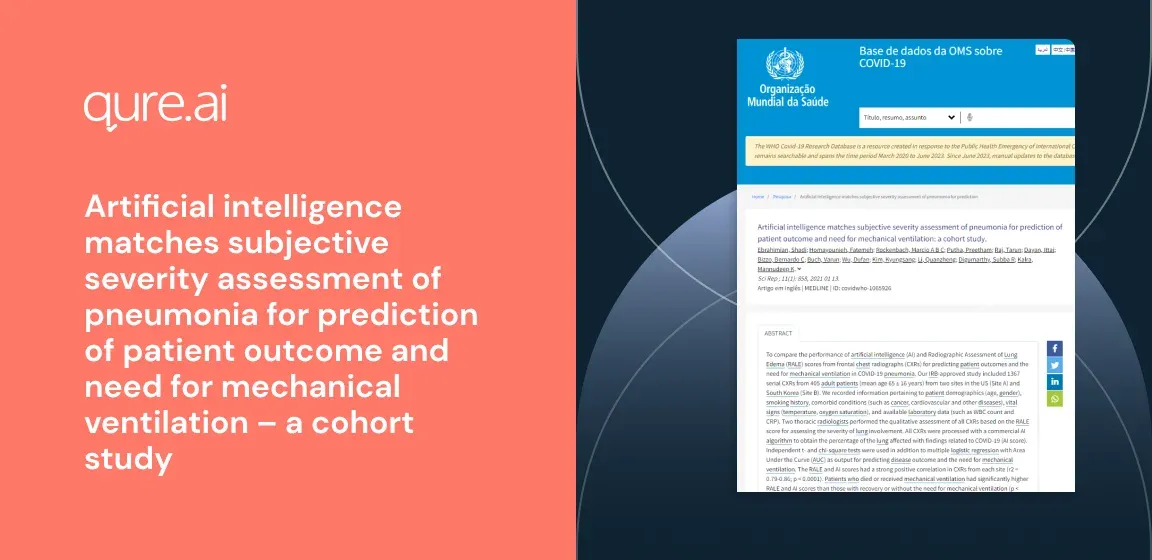Abstract
Published 12 Jan 2021
Artificial intelligence matches subjective severity assessment of pneumonia for prediction of patient outcome and need for mechanical ventilation – a cohort study
Author: Shadi Ebrahimian 1, Fatemeh Homayounieh 1, Marcio A. B. C. Rockenbach 2, Preetham Putha 3, Tarun Raj 3, Ittai Dayan 1, Bernardo C. Bizzo 1, Varun Buch 2, Dufan Wu 1, Kyungsang Kim 1, Quanzheng Li 1, Subba R. Digumarthy 1, Mannudeep K. Kalra 11

Back
To compare the performance of artificial intelligence (AI) and Radiographic Assessment of Lung Edema (RALE) scores from frontal chest radiographs (CXRs) for predicting patient outcomes and the need for mechanical ventilation in COVID-19 pneumonia. Our IRB-approved study included 1367 serial CXRs from 405 adult patients (mean age 65 ± 16 years) from two sites in the US (Site A) and South Korea (Site B). We recorded information pertaining to patient demographics (age, gender), smoking history, comorbid conditions (such as cancer, cardiovascular and other diseases), vital signs (temperature, oxygen saturation), and available laboratory data (such as WBC count and CRP). Two thoracic radiologists performed the qualitative assessment of all CXRs based on the RALE score for assessing the severity of lung involvement. All CXRs were processed with a commercial AI algorithm to obtain the percentage of the lung affected with findings related to COVID-19 (AI score). Independent t- and chi-square tests were used in addition to multiple logistic regression with Area Under the Curve (AUC) as output for predicting disease outcome and the need for mechanical ventilation. The RALE and AI scores had a strong positive correlation in CXRs from each site (r2 = 0.79–0.86; p < 0.0001). Patients who died or received mechanical ventilation had significantly higher RALE and AI scores than those with recovery or without the need for mechanical ventilation (p < 0.001). Patients with a more substantial difference in baseline and maximum RALE scores and AI scores had a higher prevalence of death and mechanical ventilation (p < 0.001). The addition of patients’ age, gender, WBC count, and peripheral oxygen saturation increased the outcome prediction from 0.87 to 0.94 (95% CI 0.90–0.97) for RALE scores and from 0.82 to 0.91 (95% CI 0.87–0.95) for the AI scores. AI algorithm is as robust a predictor of adverse patient outcome (death or need for mechanical ventilation) as subjective RALE scores in patients with COVID-19 pneumonia.
Authors
Shadi Ebrahimian 1, Fatemeh Homayounieh 1, Marcio A. B. C. Rockenbach 2, Preetham Putha 3, Tarun Raj 3, Ittai Dayan 1, Bernardo C. Bizzo 1, Varun Buch 2, Dufan Wu 1, Kyungsang Kim 1, Quanzheng Li 1, Subba R. Digumarthy 1, Mannudeep K. Kalra 11
Citation
1. Department of Radiology 2. Massachusetts General Hospital and the Harvard Medical School 3. 75 Blossom Court 4. Suite 248 5. Boston 6. MA 7. 02114 8. USA 9. MGH & BWH Center for Clinical Data Science 10. Boston 11. MA 12. USA 13. Qure.ai 14. Mumbai 15. India 16. Gordon Center for Medical Imaging 17. Bartlett 501 18. 55 Fruit Street 19. Boston 20. MA 21. 02114 22. USA